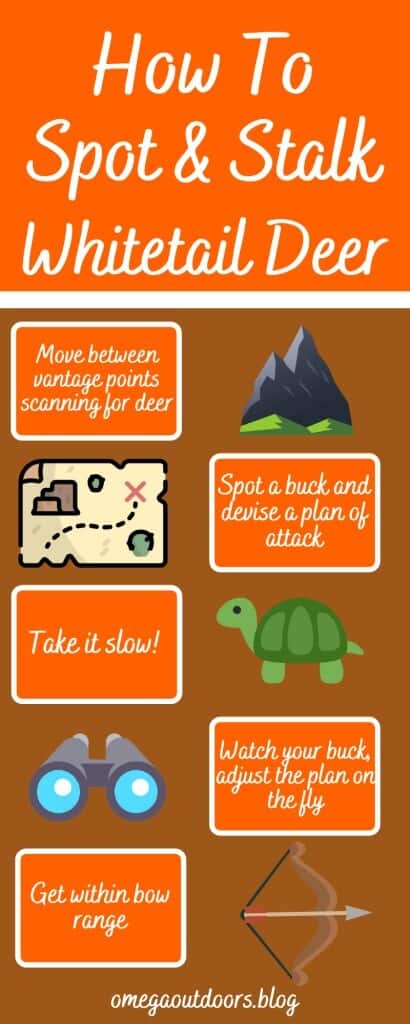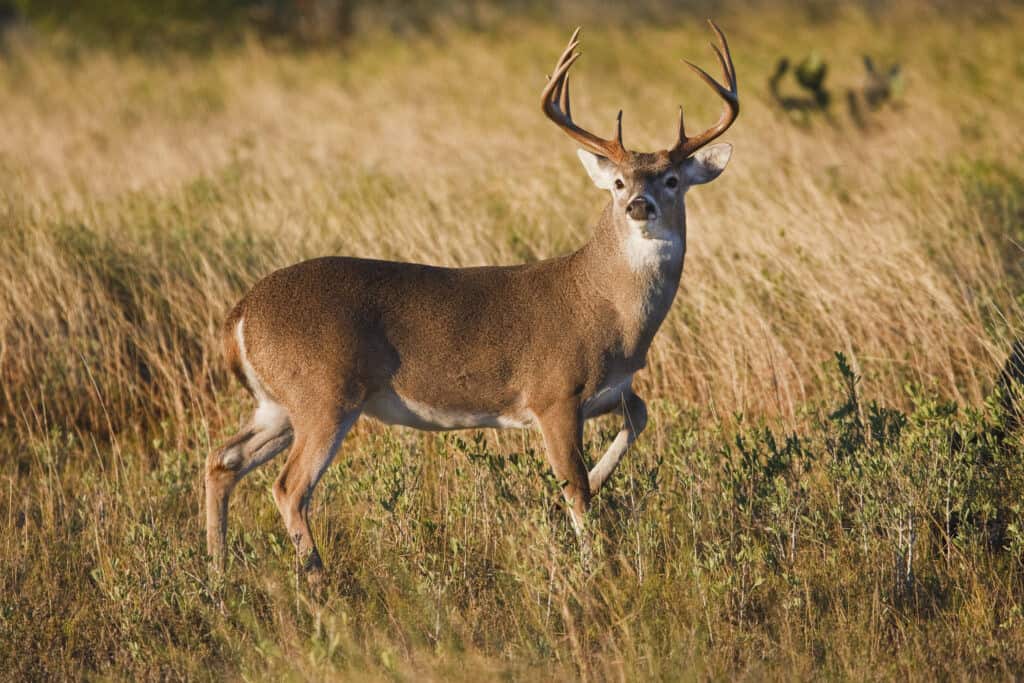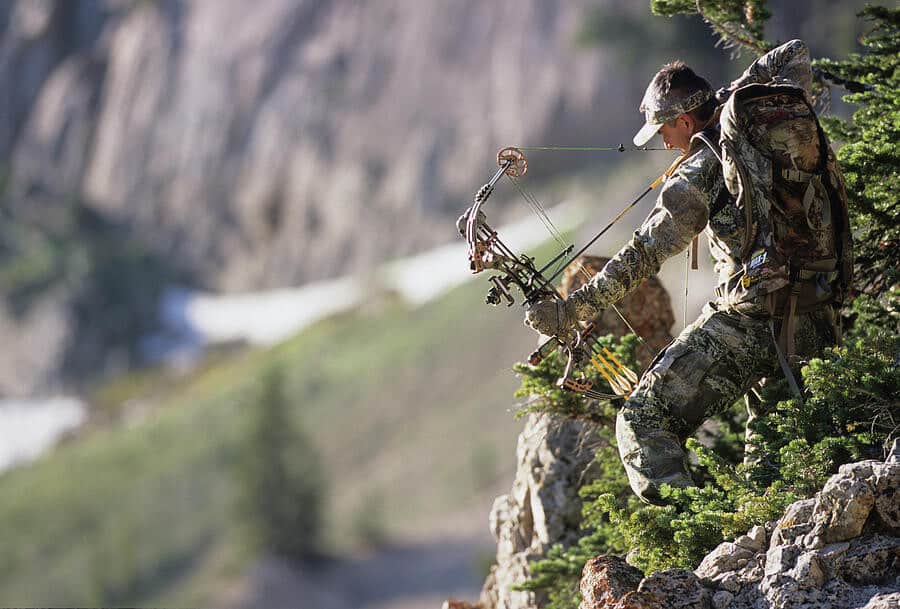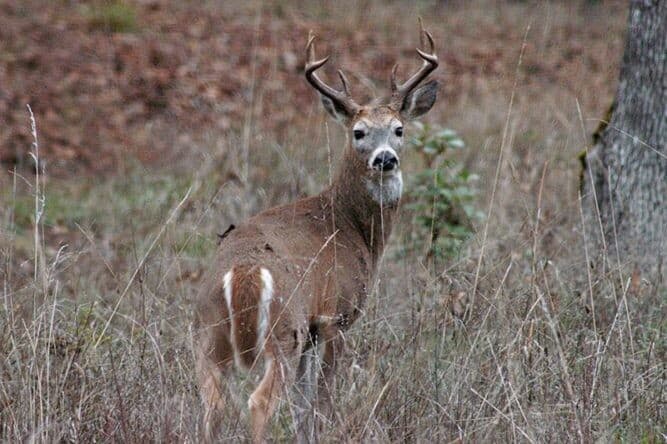Sometimes waiting for deer in a tree stand just doesn’t get the job done. A more exciting and involved strategy for bagging whitetail is the spot and stalk. Plenty of hunters have had significant success with stalking whitetail, and truth be told, we have been using this strategy for thousands of years. Although with modern tools we can be much more effective than our ancestors. Spot and stalk sounds simple at first, but when you get out in the woods and try it, you will find out it is much easier said than done. Let’s dive into exactly what the spot and stalk strategy is all about and how you can use it to become a better hunter.
The Big Idea – What Is Spot and Stalk?
The spot and stalk strategy is one of the most exciting ways to hunt in my opinion. Every time I get within 100 yards of a whitetail that I am trying to sneak up on, my heart pounds so loud that I am pretty sure they can hear it! It gets even more exciting when it all comes together and you put a deer on the ground.
The big idea behind the spot and stalk strategy is to “spot” a whitetail from far away and then slowly and silently “stalk” them until you can get close enough to get a clean shot. Typically this is done with a bow while hunting whitetail, but the spot and stalk strategy as a whole is very malleable and widely used across all of hunting.

What to Wear on a Spot and Stalk
When you are 50 yards away from a buck you have been stalking for an hour, the last thing you want is a part of your clothing to make some sort of unwarranted noise. You need to wear materials that do not make noise when they move. You should also stay away from things that will jingle, like loose zippers. Basically, you want to make sure all of your clothes are as silent as possible, and if you miss or forget about something that makes noise, the deer will kindly point it out for you.
Another thing is making sure that you wear comfortable boots. You may have to walk quite a ways to get to a buck. Some hunters choose to take their boots off when they get close to deer, this way they can walk much quieter than they could with their boots on. Personally, I do not do this and I typically chuckle whenever I see someone doing it online, but to each their own.
Only Take the Gear You Need
You also want to make sure that you are not lugging around a ton of gear with you when you go on a stalk. You should only take what is absolutely necessary. Here are a few things that are absolutely necessary: your bow, quiver, bow release, range finder, and maybe a wind indicator. I recommend leaving backpacks, binoculars, and all the other junk hunters buy behind. The fewer things you have to mess with the better chance you have at getting within range of your buck.

Get to a Vantage Point
If you have not already spotted a buck, you are going to want to find some sort of vantage point to look from. Things like mountain/hilltops, or the edge of a wide-open space will be good places to look from. Basically, you want to go anywhere that allows you to see for a long way. The more you can see, the better chance you have to see a buck.
You are also going to want to keep moving from vantage point to vantage point. You want to thoroughly scan the area from each vantage point, but after a while, if you do not see anything, you need to move on to the next spot. It is also very likely that you will see deer while you are walking between vantage points. You should be moving often while stopping for short periods of time at spots that allow you to see a long way until you find a deer.
Here is a good and exciting example from the hunting public when they spotted a bedded buck from a cliff.
Plan Out Your Approach
This is the most important part of the whole strategy. Once you finally do find a deer that you want to take down, it is crucial that you stop for a minute and think about how you are going to stalk it. If you just start going after it without much thought, you are probably going to fail.
Unless your deer is bedded down, you should expect it to move around. So if you have to break your line of sight with it, your deer may not be in the same place the next time you see it. Plan out your approach based on the terrain and your surroundings. You can also approach them from the downwind direction, which may help if you are sweating.
You also have to be able to change your plan on the fly. Plenty of things can happen between a sighting and a shot. Your deer could move, it could be scared off by something else, you may have to navigate your way around other deer that pop up, or you may find out some sort of information that helps you come up with a better plan of action. There are near infinite possibilities, but as long as you are able to adapt to the situation, you should be able to get a shot off.
Use Your Surroundings to Your Advantage
The one thing that will contribute to repeated success while stalking is the ability to effectively use the terrain to your advantage. It is also something that we can not put a broad label on. For example, I can not say that in a woodland area you should always do x y and z. It depends on your specific location, which is different for everyone.
That being said, there are a few best practices while stalking. Here is a list of a few tips related to using the terrain and your surroundings to your advantage:
- Stay off of hill tops/ridge lines – your outline stands out much more when there is nothing behind you. Walk on one side or the other of a ridge. Aka do not “skyline” yourself.
- Use the surrounding brush to hide your outline or to duck behind when a deer is close.
- Stay low to the ground when you get close – this will help you blend in more and keep you hidden. You can also walk in ditches or small valleys to accomplish this as well.
- Crouch walk between corn rows – This is what I did the first time I tried to stalk a whitetail, it works great to hide you, as long as you do not trip on a corn stalk like me…
- Working downhill is better than uphill – In the ideal scenario, we want to work on flat ground or going downhill. It is much easier to see when working downhill and you are able to adjust to the situation quicker than when working uphill. Plus working uphill is much more physically demanding.

Take It Slow – Seriously Slow
Second only to making a plan, taking it slow is super important. You want to walk super slow and quietly. The moment you rush things will be the moment you mess up. Taking it slow does two things, first it makes you quieter and less prone to snap a twig or make other loud noises. Secondly, it keeps your movement from being seen. Whitetail are very good at seeing movement, and if you are quickly (but quietly) walking towards them, they will see you. The slower you go, the better your chances will be of getting within shooting range.
To be honest this is going to be a lesson you learn the hard way, at least it was for me. The first time I decided to stalk a whitetail was the last day of my hunt about 15 minutes before dark. Two deer came out in the field back behind me and they were the only deer I had seen all day and I was pretty sure they would be the last deer I saw during that hunt. So I flew down my stand and got out in the corn field they were walking across. It was getting dark quickly and I was not going to be able to see through my peep sight in a matter of minutes, so I was in a hurry. Only to get 60 yards away and step on a corn stalk, when sent the deer off running for the hills.
Watch Their Body Language
You want to keep a close eye on the deer you are after, their body language can tell you a lot about what they may do next. If their ears and head are up and scanning, they may be slightly alerted and that can tell you to stop for a few minutes and let them calm down. If they are feeding with their head down, that could mean you are in the clear to proceed. Body language is hard to put into words, but as a hunter you learn what their movements mean over the years and it becomes a skill.

Their body language can also tell you if another deer is coming. During a spot and stalk, our prey is ideally alone, but many times there could be multiple deer in the area. This makes it much harder. Having to creep within bow range of multiple deer, with excellent sight, hearing, and smell is definitely a challenge. That is why when you are working towards a deer, make sure to keep scanning your surrounding area as well. Your deer may be alone, but that does not mean there is not a deer walking in your direction on your right. All it takes is for you to ignore or not notice them and then they will bust you. When they start stomping or blowing, it will probably spook the deer you are after. Plus, if you are watching out for other deer, you may find a bigger buck than you were originally going after.
Use Your Range Finder
When you start getting close to a deer you have been stalking, it can be easy to think you are closer than you actually are, especially if you are really excited or started stalking them from a few hundred yards away. That is why I consider a range finder to be one of the essential pieces of gear for stalking, at least while you are using a bow. Use your range finder often. You will probably be surprised how far away you actually are. When you get close enough to take a shot, quickly range the shot so you can use the right pin on your sight. It would be terrible to put all that work in just to miss your shot because you thought you were at 30 yards but you are really at 45.
When You Should Use Spot and Stalk
So now that you know how to spot and stalk, when should you do it? Would you be better off sitting in a tree stand that day? No one knows. Although a great time to try out spot and stalk is on windy or gloomy days. So if you are not so sure about stalking over sitting in your stand, a good rule of thumb could be to try it out when it’s a bad day to sit in a stand. You can never really know which one would be better, but it is worth a shot.
Spot and stalk works best during midday up until about 4 pm. During this time whitetails are focused on bedding down and chewing their cud after feeding all morning. The less they move the closer you can get, so it makes sense to go after them when they are moving the least.
A slight rain could also be a great time to try out a spot and stalk. As long as it is not too heavy and you are able to move around, it will wet the ground and add a bit of noise to the woods. Both of these things make it easier for you to move around and make deer more forgiving when you slip up.
Conclusion
Spot and stalk is a super fun and effective strategy for hunting whitetail deer. It can be hard to learn at first, and if you have never done it you will mess up, but that is fine. The more you mess up the more you will learn. In my opinion, deer hunting is 90% about the experience rather than the kill. So just make sure that after you finally spot a buck you want to go after, that you slow down, make a plan, and adjust that plan as needed. Stalking is a skill that takes years to hone, but it is certainly worth it.

